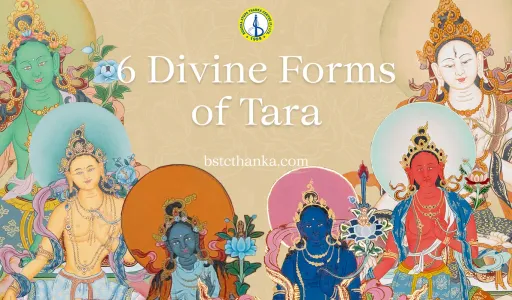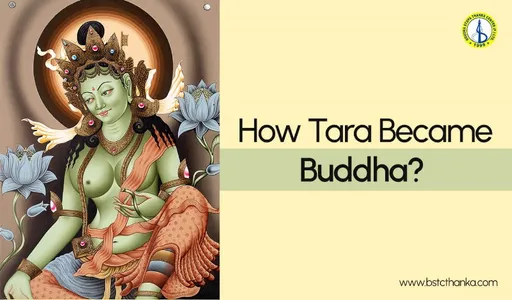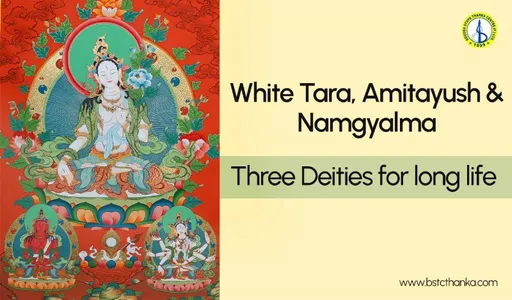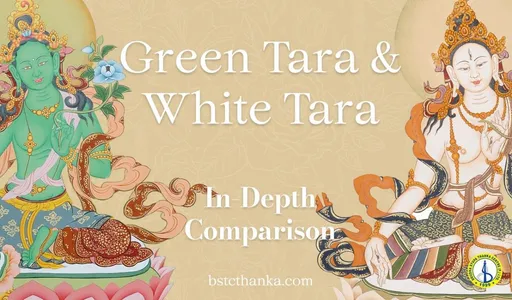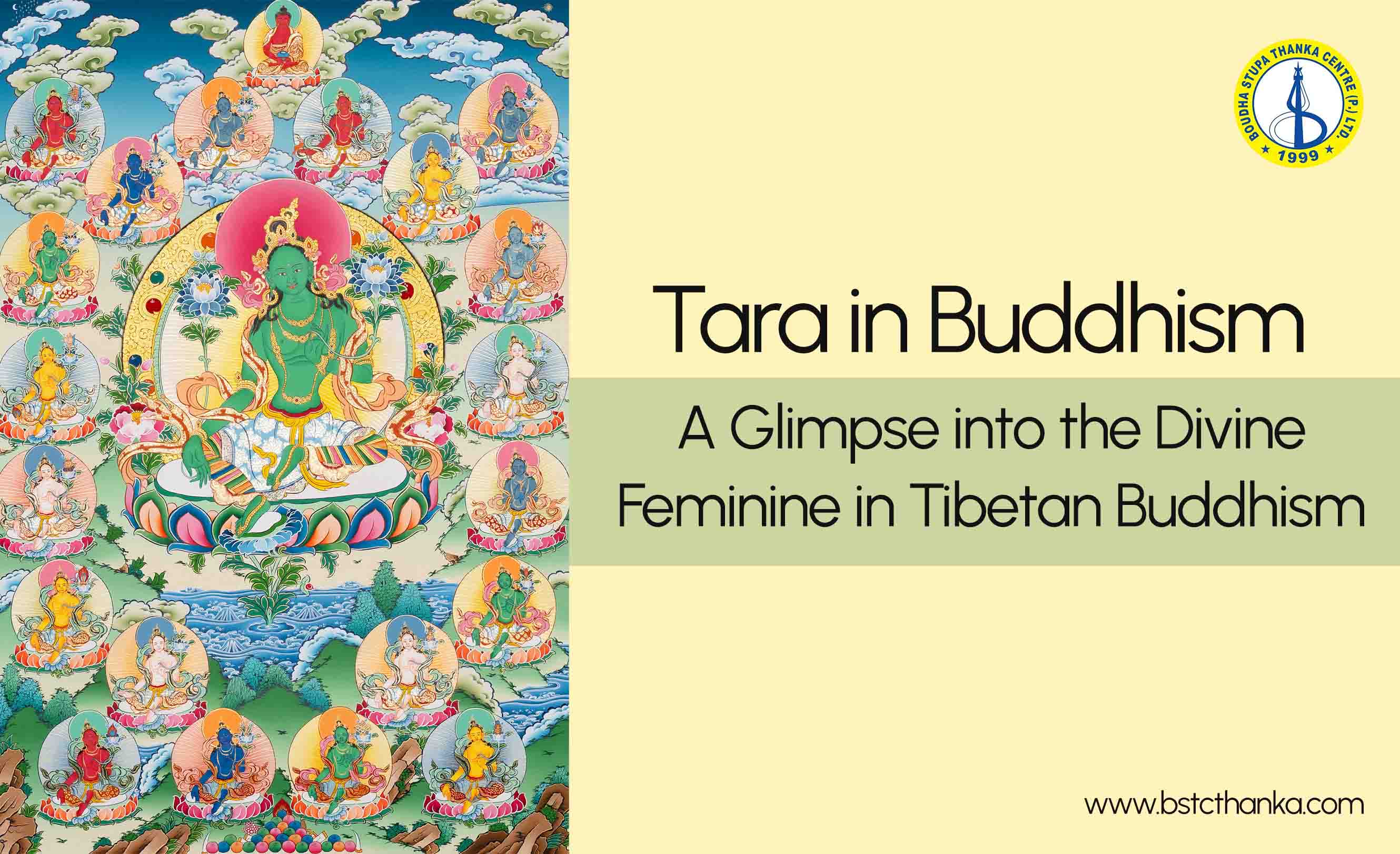
Who is Tara in Buddhism? The Female Buddha
In the traditional pantheon of Vajrayana and Mahayana Buddhism, Tara is the feminine Buddhist deity of compassion and wisdom. She appears as the female consort of Avalokiteshwara and exists in eternal enlightenment to save all beings from the afflictions in life. Described as the “mother of all Buddhas”, Tara embodies the maternal element of nurture, protection and generosity, contributing to her revered position in Buddhist practices.
In Tibetan Buddhism, the imagery of Tara is manifested in twenty-one primary forms, each encompassing unique appearance and qualities. Her profound wisdom and enlightenment is reflected in her role as a meditation deity for spiritual liberation from samsara, the cycle of existence. Contemplation of Tara is believed to bestow practitioners with guidance towards the path of enlightenment, making her the most powerful Buddhist goddess.
History and Origin of Tara the Buddhist Goddess
The origin of the name ‘Tara’ is often associated with its Sanskrit meaning ‘star’. Similar to how a star helps in navigation of directions, the goddess Tara guides her devotees to navigate their spiritual path to enlightenment. Tara also means ‘to cross’, which signifies her role as a rescuer who helps all sentient beings to cross the ocean of sufferings throughout the samsara in order to finally reach the shores to eternal peace. Her devotees particularly find solace in her blessings when they seek liberation from the obstacles in life.
Tara is said to have emanated from the tears shed by Bodhisattva Avalokiteshwara when he cried over the hardships of the world, forming a lake of empathy. From the lake grew an utpala (a blue lotus), which blossomed to reveal Tara, the feminine personification of boundless compassion. Tara represents Avalokiteshwara’s unwavering determination in easing obstacles of beings and guiding them towards ultimate enlightenment. She selflessly imparts her wisdom and assistance as the Savioress of all beings.
Another popular narrative of Tara’s origin depicts her as the embodiment of Buddhist feminism. The tale depicts that the princess of Wisdom, Yeshe Dawa, ceaselessly worshipped and attained bodhicitta, the boundless compassion of Bodhisattva. She was blessed by monks to be reborn as a male to attain further enlightenment. However, she dispelled the gender barrier by vowing to be born as a female who is equally capable of attaining spiritual enlightenment. Tara is her reincarnation as a female Bodhisattva, embodying feminine divinity and innate wisdom that women can embrace to be enlightened.
Role and Symbolism of Tara Deity in Tibetan Buddhism
Tara is worshipped in Tibetan Buddhism as the female Bodhisattva capable of guiding her disciples to enlightenment. Also called the 'Goddess of Perfected Wisdom’, she is known to impart her knowledge and enlightened wisdom to help disciples remove malevolent energies and fear from their minds to attain peace. Her role as a liberator enables her to expel the hardships of the world, helping all beings to walk towards enlightenment. She stands as the supreme embodiment of maternal love, protection and eternal wisdom in Buddhism.
The significance of Tara is exceptionally reflected in her symbolic imagery, depicted in forms of her posture and gestures. She gracefully sits on a lotus throne, radiant with bright color attire and adorning jewelry. In Buddhist iconography, she frequently appears with a third eye, indicating her enlightened persona. Her image reflects the attributes associated with her multifaceted forms.
Color
The main form of Tara is depicted in dark green color, signifying her enlightened state. It is believed that the color encompasses all other colors in itself, which is why Tara's green form embraces all the qualities of Tara’s 21 manifestations. In Buddhist symbolism, each color Tara represents her distinct feature; Red Tara signifies power, White Tara provides longevity, and Yellow Tara bestows abundance upon the sentient beings. Each of Tara’s divine manifestations is pivotal to her revered essence in Buddhist spiritual practices.
Posture
Tara is usually presented gracefully seated, and sometimes standing on a fully bloomed lotus throne. While seated with her legs crossed, her right leg partially extends forward to rest on a smaller lotus. It suggests her readiness to help beings tackle the obstructions in life. Her posture, often called the one of the “delightful goddess” or Lalitasana typically conveys her regal imagery. Her right hand stretches outward, and the left hand is placed close to the heart. Tara is depicted in her most serene form, radiating peace and compassion from her illuminating image.
Hand Gestures (Mudras)
The hand gestures of Tara symbolize her willingness to impart wisdom and compassion. Her right hand extends downward in the mudra of generosity (varada mudra), signifying her readiness to bestow blessings on all the sentient beings. Her left hand, placed closed to her heart with the palm facing outward in the vitarka mudra, represents her protective nature and fearlessness. The significance of Tara is exceptionally depicted by the symbolism of her mudras.
Lotus Flower
There is a great importance of the lotus flower in Tara’s imagery. It not only signifies the story of her origin, but also transcends to her essence of giving. The blossoming of lotus on her left hand signifies how wisdom blooms to attain enlightenment. The blue lotus (utpala) is known to bloom at night, indicating Tara’s association with the moon. Her lotus throne symbolizes Tara’s purity and divinity, which are central to her essence in Buddhist faith.
Eyes
The iconography of Tara usually represents her with a third eye on the forehead, symbolizing the eternally enlightened state of Tara, from where she imparts wisdom to all beings. In some of her forms, she has seven eyes, each on her palms and foot soles, signifying her all-seeing wisdom. It symbolizes her alertness to the sufferings off all her devotees so that she can swiftly impart guidance and direction to all feeling lost in the ocean of hardships.
Jewelry and Attire
Tara is presented as a young woman adorned with bright jewels and ornaments. Her head olds a magnificent crown and her neck, hands, arms and foot are covered in golden jewels, portraying her regal state. She wears a silk attire because silkworms are known to represent the path of Buddha. Her body is covered with a silk upper garment, a silk skirt and a long silk scarf, adorning her beautiful imagery.
Different Forms of Tara
In Tibetan Buddhism, Tara appears in as many as 21 primary forms, with each form bearing unique significance and symbols. All of Tara’s roles embody her maternal and generous persona, however, they are unique in their own ways. Her most popular forms are in four of the following manifestations.
1. Green Tara
Green Tara in Buddhism is believed to be the goddess of protection. Reciting the Green Tara mantra provides swift compassion to those in unfortunate circumstances. Green Tara is said to have emerged from the compassionate tear of Avalokiteshwara’s right eye. Practitioners often hang Green Tara thangka in their homes because it symbolizes protection, compassion, and swift help overcoming obstacles. It serves as a spiritual guide, offering comfort and support in times of need.
2. White Tara
In Buddhism, White Tara represents healing and generosity. She is known to bestow the blessings of longevity and compassion to all beings. Chanting mantra of White Tara is known to protect one from physical and emotional afflictions. Chinese princess Wengchen was worshipped as the manifestation of White Tara. Hanging a White Tara thangka in homes is believed to invite protection, long life, and healing energies. This sacred image is thought to bring blessings, promote health, and create a peaceful atmosphere in the household.
3. Red Tara
Red Tara has powerful and magnetizing qualities, and is known to control all evil influences and bestow protection from obstacles. She restores positive energies and calmness in ones’ life. Devotion to Red Tara inculcates fearlessness and bravery.
4. Yellow Tara
Yellow Tara is the deity embodying wealth and abundance. In her radiant gold imagery, she bestows profound fortune and prosperity and eliminates material and spiritual poverty. Seeking her solace is known to expel absence of resources.
Why People Buy Tara Thangka?
The significance of the female Buddha Tara is manifested in the exquisite artwork of Thangka painting. The painting not only serves as a reminder to the benevolence of Tara, it also functions as a visual aid for meditative prayer practices. Tara Thangka is used by many as a meditation tool to contemplate her divinity and manifest protection from the hardships of life. Mantra of Tara is used for internalizing compassion, for which the Tara Thangka is popular among practitioners. Besides, the traditional artwork of the Tara Thangka enhances the aesthetic appeal of any space. Adding a Tara Thangka to ones’ collection can be the right decision to magnetize positivity into their life.
Conclusion
Tara is the venerated Buddhist goddess of unbound compassion and profound wisdom. Motherhood is central to her essence, and she emits maternal qualities of nurture, care and protection to all sentient beings for them to reach the ultimate enlightened state. Her significance in Buddhist practices is wide and eternal, from her legendary origin to her multifaceted roles in Buddhist practices. She is a guiding force to those seeking her solace, her devotion, often through meditation, prayer and chanting, can bring about spiritual growth and peace in one’s life.
FAQs
How is Tara relevant to those who do not practice Buddhism?
While Tara’s significance is immense in the Buddhist sect, she is equally relevant to non-Buddhists who are willing to embody her compassionate energy. You can use the image of Tara to perform meditative and spiritual practices, or even to simply visualize her form for you to magnetize positive energy into your lives.
What is the mantra of Tara?
The mantra associated with Tara is “Om Tare Tuttare Ture Soha”, which you can recite to seek solace in Tara’s assistance in dealing with hardships.
How can one worship Tara?
You can choose to worship Tara as per your preference. One can recite her mantra, meditate on her image, perform sadhanas, ritual offerings or envision her image to practice with Tara and embody her qualities.
Why is Tara depicted in different colors?
Tara exists in twenty one manifestations, each embodying distinct qualities reflected by the color of her form. The main form of Tara exists in dark green color because it is known to be the combination of all other colors of Tara.





